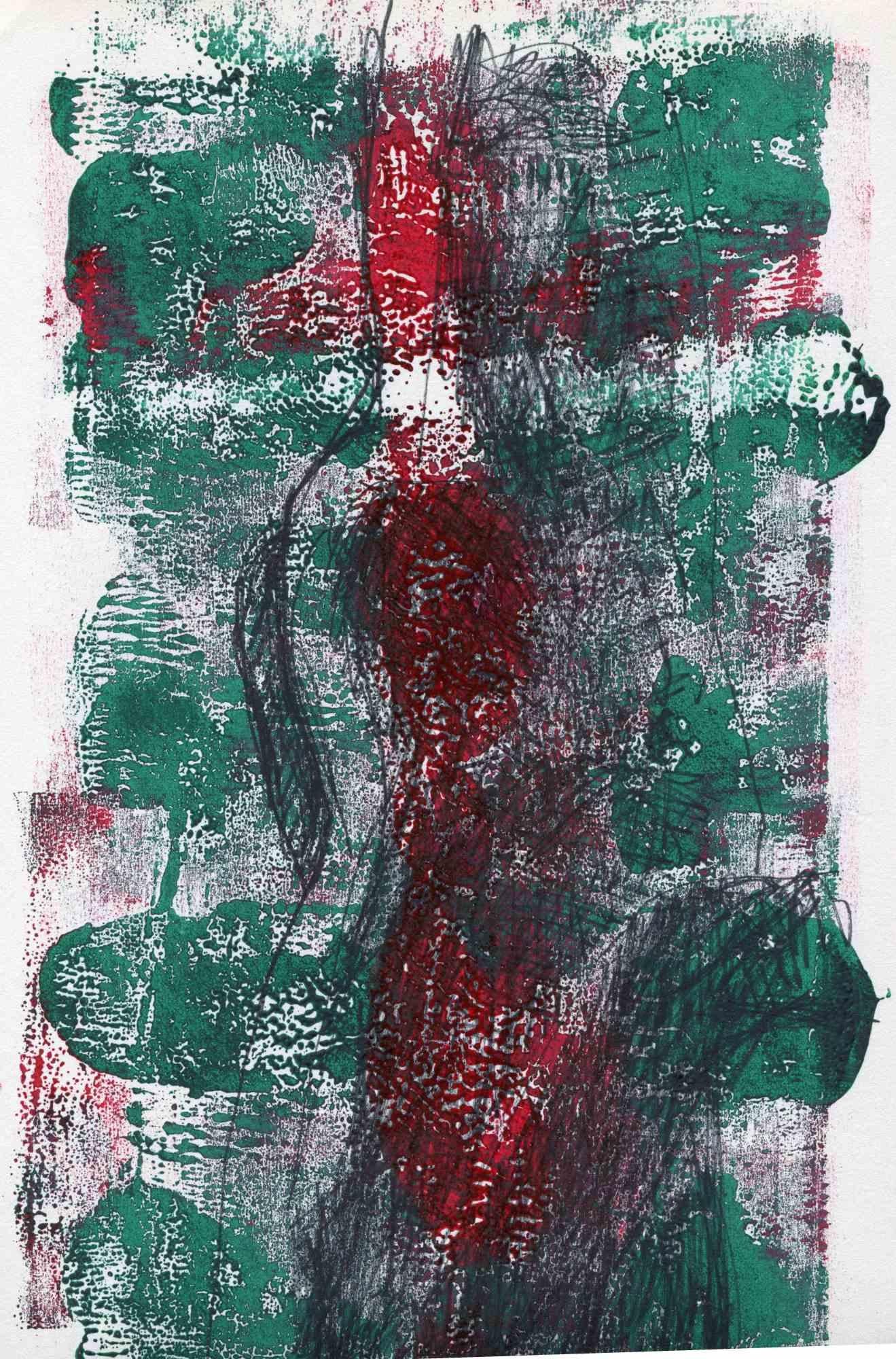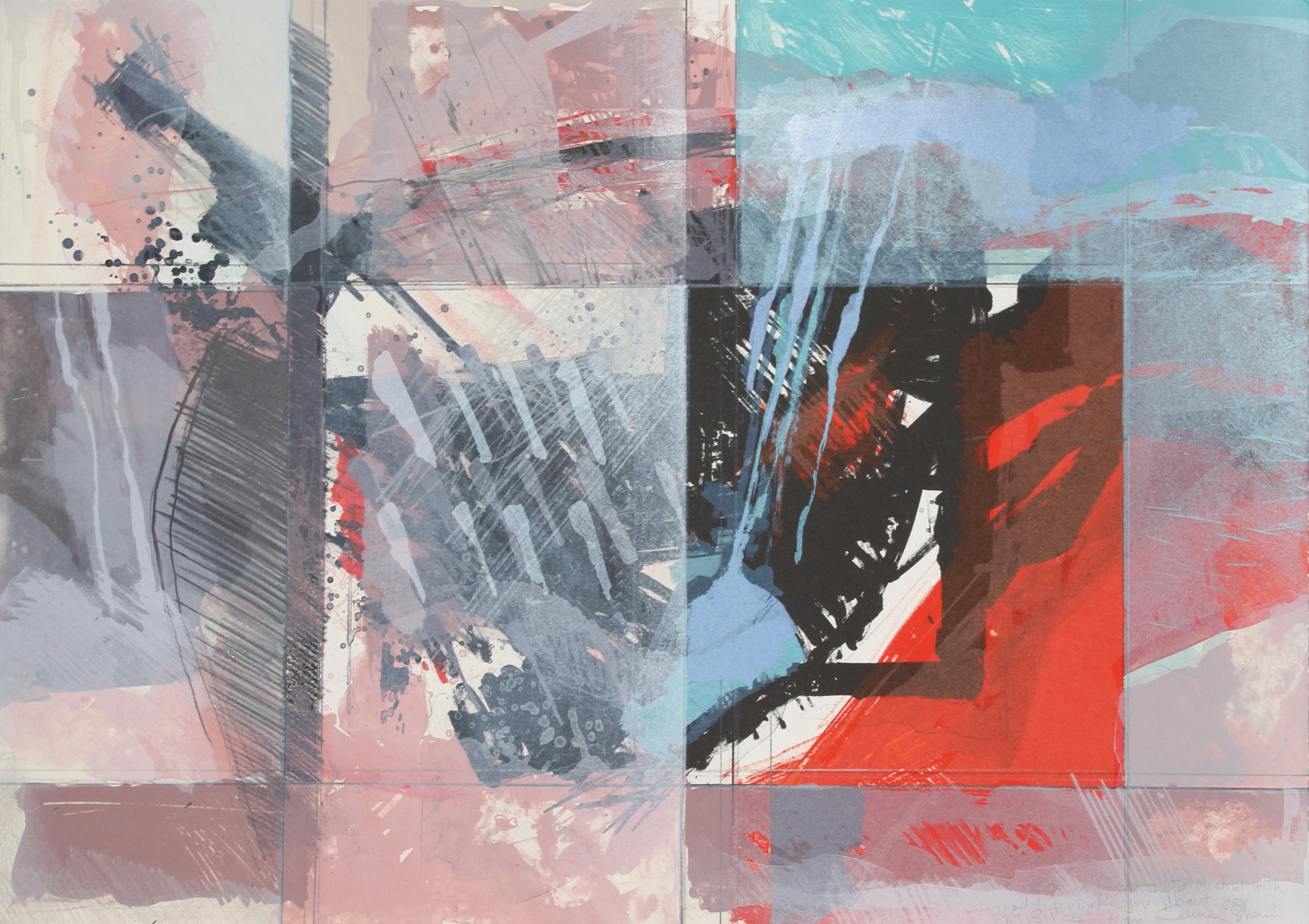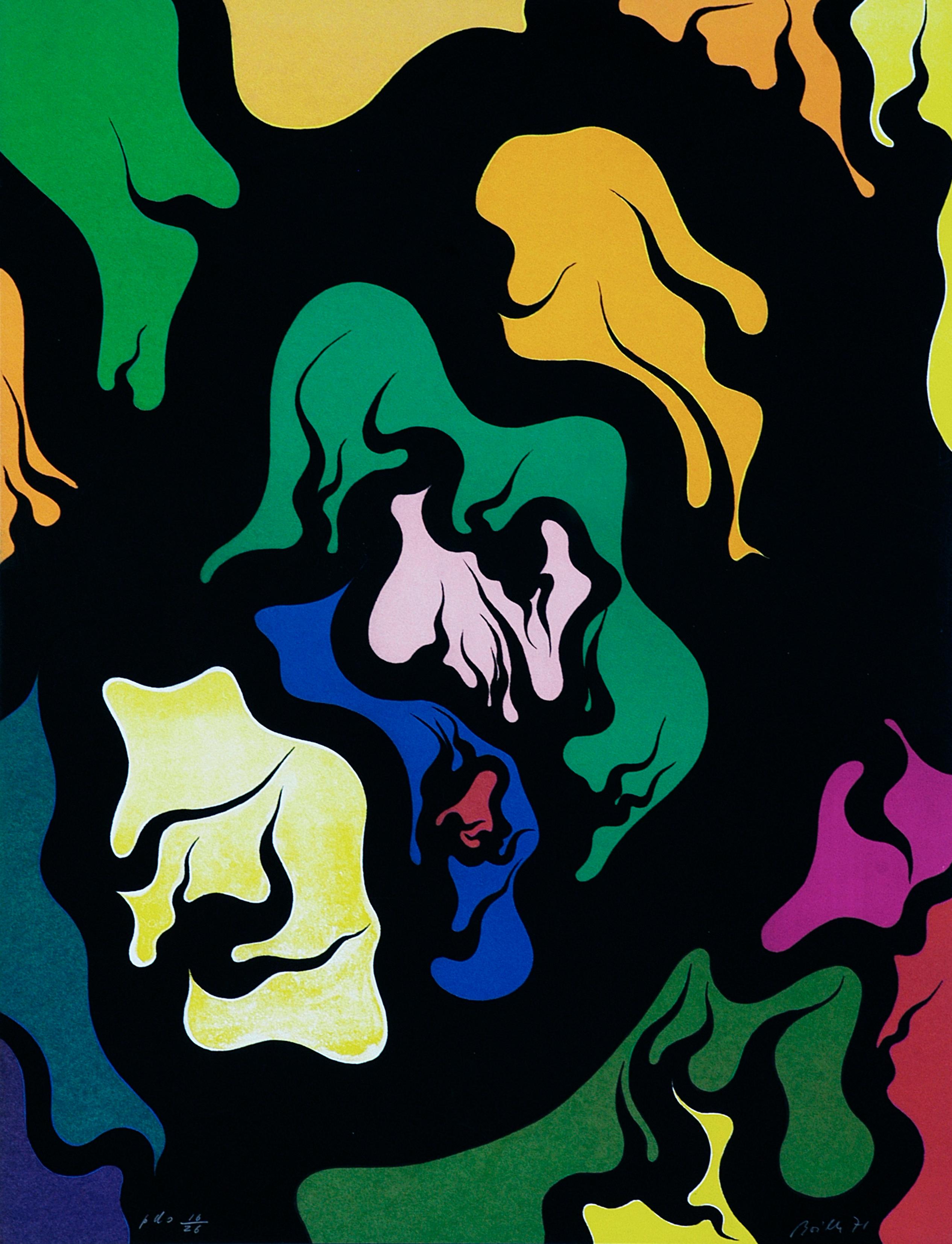Items Similar to Geometric Composition with Red Diamond
Want more images or videos?
Request additional images or videos from the seller
1 of 5
Ilya BolotowskyGeometric Composition with Red Diamond
About the Item
Signed and Numbered Ed. 125
The following is excerpted from The New York Times, August 6, 2001 by Daniel Watkin:
"Shedding 7 Coats, a Beauty Emerges on a Hospital Wall"
By DANIEL J. WAKIN
For nearly six months, the men of Ward B-11 watched restorers chip and dissolve their way through seven coats of institutional paint. They breathed the mingled odors of solvent and hospital food. They wondered at the stream of important-looking visitors to their day room.
And they witnessed the resurrection of a 1941 landmark of abstract art in America.
It is a mural by the Russian-born artist Ilya Bolotowsky in the circular day room at Goldwater Memorial Hospital on Roosevelt Island. The 350-square- foot assembly of lines, right-angled shapes and pastel colors has undergone a complete restoration, which was completed on Monday.
The mural lay hidden and forgotten for decades, a victim of the passive neglect of bureaucrats, until it was featured in 1991 by the Municipal Arts Society's Adopt-a- Mural program and funding was pieced together for the restoration.
"It's an absolutely wonderful thing," said Andrew Bolotowsky, the artist's son. "My father was very serious about this particular work, as he was about all his works. It was very dear to his heart."
In his lifetime, Bolotowsky, one of the nation's first important abstract painters, knew his mural had been painted over. But he did not speak about it often, his son said. "The things that were most important to him, he was quiet about," Andrew Bolotowsky said.
In 1981, Bolotowsky began reproducing the mural as an acrylic painting, but he died before finishing the canvas. The mural faded from memory. Now it is back, and the tale of its excavation carries a fair number of twists and turns. So did the life of Bolotowsky.
Bolotowsky (boh-loh-TUFF-skee) was born in 1907 in St. Petersburg, the son of a lawyer and an artist. The family fled the Russian Revolution for Constantinople, and immigrated to the United States in 1923. Bolotowsky attended the National Academy of Design in New York, served in the Army as a technical translator in Alaska, made movies, and wrote plays and short stories.
He had a Balkan-style mustache and a photographic memory. He played Bach slowly and romantically on the harpsichord. For exercise as a young man, Bolotowsky would walk from Manhattan to Tarrytown, N.Y., and back. As a father, he would take his son on walks lasting hours to lectures on "anything and everything," Andrew Bolotowsky said.
Bolotowsky was a founder, in 1936, of American Abstract Artists, a group that included Piet Mondrian, Ad Reinhardt and George L. K. Morris. They created purely abstract art in a style that came to be known as Neo-Plasticism.
Like many abstract painters of his time, Bolotowsky is not very well known, said Debra Balken, a historian of American modernist art and independent curator. But scholars and art lovers are beginning to rediscover the period.
"His contribution was keeping alive abstract painting during the decade of the 30's," she said. "It was the decade of the Depression. It was not fashionable to be an abstract painter."
As Bolotowsky was beginning American Abstract Artists, the Federal Works Progress Administration commissioned him to create a mural, one of the first abstract murals in the country, for the Williamsburg Housing Project in Brooklyn.
The W.P.A. also hired him to paint a mural at the hospital, at the time called the Hospital for Chronic Diseases, on what was then called Welfare Island. Bolotowsky was a second choice. (Wiser heads prevailed when the first choice, Byron Browne, proposed a photomontage of vigorous young athletes, perhaps not ideal for a hospital that was built in 1939 for tuberculosis patients.)
"The most suited design for a hospital mural should contain no definite subject matter but should be generally soothing in its line and color," Bolotowsky wrote in his proposal.
In the post-World War II years, institutions lost a taste for government-funded art, particularly abstract works, and many of the hundreds of W.P.A. murals in New York fell on hard times. Bolotowsky's mural was painted over.
Samuel Lehrfeld, the executive director of Goldwater, part of the Coler- Goldwater Specialty Care Hospital and Nursing Facility, has served in some capacity at the hospital since 1972. He said he learned about the mural's existence somewhere on the grounds in the early 1980's. "If we had seen that mural, and if anybody had painted it, there would have been somebody dead here," he proclaimed.
Bolotowsky embarked on his project to recreate the work, plus two others feared lost, in 1979.
A lucky stroke helped. Years earlier, Jackson Pollock came across a scaled- down preliminary version of the mural in a pile of W.P.A. materials, Andrew Bolotowsky said. Pollock retrieved it; his wife, the artist Lee Krasner, later donated it to the Guggenheim Museum. Bolotowsky photographed the scale version to use for his acrylic reproduction.
On a gray November day in 1981, as he was on his way to let in a visitor, Bolotowsky stepped through the manually operated doors of the freight elevator at his Lower Manhattan loft. He was unaware that the elevator was at the ground floor; he plunged down the shaft and died. Andrew Bolotowsky still has the charcoal sketch his father was working on at the time for the central panel of the mural reproduction.
- Creator:Ilya Bolotowsky (1907-1981, American, Russian)
- Dimensions:Height: 30 in (76.2 cm)Width: 22 in (55.88 cm)
- Medium:
- Movement & Style:
- Period:
- Condition:
- Gallery Location:Missouri, MO
- Reference Number:1stDibs: LU74732277871
Ilya Bolotowsky
Ilya Bolotowsky grew up in Russia and enjoyed drawing, but his family wanted him to do something “socially useful,” so he planned to be a lawyer. He changed his mind after he moved to New York, however, and enrolled at the National Academy of Design. During the 1930s, the Works Progress Administration hired him as a mural painter, and he was one of the first artists to create completely abstract designs for the project. He composed geometric images from colored rectangles and squares, inspired by his belief in “ideal harmony and order.” From the late 1940s, Bolotowsky used canvases shaped as diamonds, circles, and ovals to show how the edge of the painting could change the visual effect of the lines and angles within. (Bolotowsky, interviewed by Svendsen and Poser, Ilya Bolotowsky, 1974)
About the Seller
5.0
Vetted Seller
These experienced sellers undergo a comprehensive evaluation by our team of in-house experts.
Established in 1970
1stDibs seller since 2017
142 sales on 1stDibs
Typical response time: 21 hours
- ShippingRetrieving quote...Ships From: Missouri, MO
- Return PolicyA return for this item may be initiated within 2 days of delivery.
More From This SellerView All
- FramedBy Sam FrancisLocated in Missouri, MOFramed Sam Francis (American, 1923-1994) Edition 58/100 in pencil Lower Left Signed in pencil Lower Right 17 x 22 inches 25.5 x 30.5 inches An Abstract Expressionist* painter known ...Category
1960s Abstract Abstract Prints
MaterialsColor, Lithograph
- Observador de PajarosBy Rufino TamayoLocated in Missouri, MO"Observador de Pajaros" 1950 By. Rufino Tamayo (Mexican, 1899-1991) Edition 83/210 Lower Right Signed Lower Left Unframed: 15.5" x 22.5" Framed: 21.75" x 28.25" Rufino Tamayo (August 26, 1899- June 24, 1991) A native of Oaxaca in Southern Mexico, Rufino Tamayo's father was a shoemaker, and his mother a seamstress. Some accounts state that he was descended from Zapotec Indians, but he was actually 'mestizo' - of mixed indigenous/European ancestry. (Santa Barbara Museum of Art). He began painting at age 11. Orphaned at the age of 12, Tamayo moved to Mexico City, where he was raised by his maternal aunt who owned a wholesale fruit business. In 1917, he entered the San Carlos Academy of Fine Arts, but left soon after to pursue independent study. Four years later, Tamayo was appointed the head designer of the department of ethnographic drawings at the National Museum of Archaeology in Mexico City. There he was surrounded by pre-Colombian objects, an aesthetic inspiration that would play a pivotal role in his life. In his own work, Tamayo integrated the forms and tones of pre-Columbian ceramics into his early still lives and portraits of Mexican men and women. In the early 1920s he also taught art classes in Mexico City's public schools. Despite his involvement in Mexican history, he did not subscribe to the idea of art as nationalistic propaganda. Modern Mexican art at that time was dominated by 'The Three Great Ones' : Diego Rivera, Jose Clemente Orozco, and David Alfaro Siqueros, but Tamayo began to be noted as someone 'new' and different' for his blending of the aesthetics of post Revolutionary Mexico with the vanguard artists of Europe and the United States. After the Mexican Revolution, he focused on creating his own identity in his work, expressing what he thought was the traditional Mexico, and refusing to follow the political trends of his contemporary artists. This caused some to see him as a 'traitor' to the political cause, and he felt it difficult to freely express himself in his art. As a result, he decided to leave Mexico in 1926 and move to New York, along with his friend, the composer Carlos Chavez. The first exhibition of Tamayo's work in the United States was held at the Weyhe Gallery, New York, in that same year. The show was successful, and Tamayo was praised for his 'authentic' status as a Mexican of 'indigenous heritage', and for his internationally appealing Modernist aesthetic. (Santa Barbara Museum of Art). Throughout the late thirties and early forties New York's Valentine Gallery gave him shows. For nine years, beginning in 1938, he taught at the Dalton School in New York. In 1929, some health problems led him to return to Mexico for treatment. While there he took a series of teaching jobs. During this period he became romantically involved with the artist Maria...Category
20th Century Abstract Abstract Prints
MaterialsLithograph
- Red and Green BubblesBy Victor VasarelyLocated in Missouri, MOVictor Vasarely "Red and Green Bubbles" c. 1970 Color Serigraph Signed and Numbered Ed. 125 Framed Size: 34 x 29.5 inches Image: approx 18 x 18 inchesCategory
1970s Abstract Geometric Abstract Prints
MaterialsLithograph
- Sphere and CubeBy Victor VasarelyLocated in Missouri, MOVictor Vasarely "Sphere and Cube" c. 1970 Serigraph Signed and Numbered Ed. 250 Framed Size: 42 x 31 inches Image Size: 28 x 21 inchesCategory
1970s Abstract Geometric Abstract Prints
MaterialsLithograph
- St. Louis Symphony Orchestra (Poster) -- signed limited editionBy Robert MotherwellLocated in Missouri, MOOriginal color lithograph designed by Robert Motherwell for the 94th Season, Powell Symphony Hall, St. Louis Symphony Orchestra From the limited edition of 120 + A.P.s on Arches Cove...Category
1970s Abstract Expressionist Abstract Prints
MaterialsLithograph
- Abstract in Purple and GreenBy Victor VasarelyLocated in Missouri, MOVictor Vasarely "Abstract" c. 1970 Serigraph Ed. 275 Signed and Numbered Image Size: 23.5 x 23.5 Framed: approx 34 x 34.5 inchesCategory
1970s Abstract Geometric Abstract Prints
MaterialsLithograph
You May Also Like
- No. 6 from "Als Mestres de Catalunya, " Lithograph by Antoni Tapies, 1974By Antoni TàpiesLocated in Long Island City, NYThis lithograph was created by Catalan artist Antoni Tapies. Tàpies started as a surrealist painter, and his early works were influenced by Paul Klee and Joan Miró. However, he soon ...Category
1970s Abstract Expressionist Abstract Prints
MaterialsLithograph
- Blue/Green Abstract Lithograph by Bruce PorterBy Bruce PorterLocated in Long Island City, NYArtist: Bruce Porter, American (1948 - ) Title: Untitled III Medium: Lithograph, signed and numbered in pencil Edition: 14 Image Size: 24 x 18 inches Size: 28 x 22 in. (71.12 x 55.88...Category
1980s Abstract Abstract Prints
MaterialsLithograph
- Abstract Composition - Original Lithograph - Mid-20th CenturyLocated in Roma, ITAbstract Composition is an original print in lithograph on paper realized by an anonymous artist of the mid-20th Century. In very good conditions. The artwork is created through co...Category
Mid-20th Century Abstract Abstract Prints
MaterialsLithograph
- Between Fog & Clarity, Colorful Abstract Lithograph by Calman ShemiBy Calman ShemiLocated in Long Island City, NYArtist: Calman Shemi, Argentine (1939 - ) Title: Between Fog & Clarity Medium: Lithograph, signed in pencil Edition: 300, Dedicated to Michel Size: 25 in. x 35.5 in. (63.5 cm x 90.17...Category
Late 20th Century Abstract Abstract Prints
MaterialsLithograph
- Plate 16, from 1965 Peintures sur CartonsBy Joan MiróLocated in Washington, DCArtist: Joan Miro Title: Plate 16 Portfolio: Peintures sur Cartons Date: 1965 Edition: Unnumbered Frame Size: 21 1/4" x 17 1/4" Sheet Size: 15" x 11" Image Size: 15" x 11" Signature:...Category
1960s Abstract Abstract Prints
MaterialsLithograph
- Black Hell - Lithograph by Luigi Boille - 1971By Luigi BoilleLocated in Roma, ITBlack Hell is a wonderful abstract composition made by Luigi Boille. This is a hand-signed lithograph. Edition of 26 copies. The green stands out more t...Category
1970s Abstract Abstract Prints
MaterialsLithograph
Recently Viewed
View AllMore Ways To Browse
Vintage Red Diamond
Red Vintage Scale
Red Door Vintage
Geometric Watch
Red Diamond Heart Shape
Dior Coat Red
Freight Elevator
Used Freight Elevators
Red Watch Diamond
Vintage Charcoal Sketch
Retro Diamond Warrings
Square Watch With Diamond
Vintage Lawyer Prints
Mens Red Watch
Diamond Dior Watch
Dior Coat S
Dior Watch With Diamonds
S And B Watches



